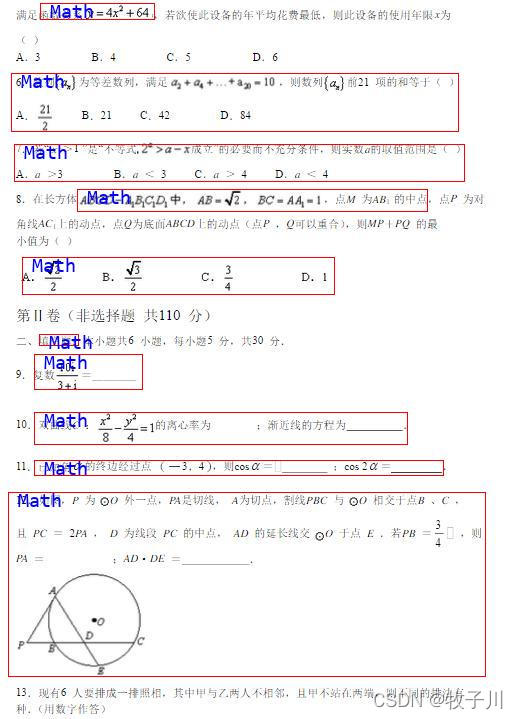
XML文件解析--Python
一、对xml的解析及其函数二、xml文件三、python解析一、对xml的解析及其函数官方手册20.5. xml.etree.ElementTree — The ElementTree XML API — Python 3.6.15 documentationXML是一种固有的分层数据格式,最自然的表示方法是使用树,其内元素称作子节点通过 parse() 解析xml文本,返回根元素 tree。(一
目录
一、对xml的解析及其函数
XML 指可扩展标记语言XML 被设计用来传输和存储数据。
XML 是一种固有的分层数据格式,最自然的表示方式是使用树。 ET为此有两个类 - ElementTree将整个 XML 文档表示为一棵树,并 Element表示该树中的单个节点。与整个文档的交互(从文件读取和写入/从文件写入)通常在ElementTree级别上完成。与单个 XML 元素及其子元素的交互是在Element级别上完成的。
其内元素称作子节点通过 parse() 解析xml文本,返回根元素 tree。(一级节点Annotation) 通过对 tree 进行findall操作,可到到带有指定标签的节点(二级节点eg:filename,object)。
xml.etree.ElementTree模块实现了用于解析和创建 XML 数据的简单高效的 API。
Element对象有以下常用属性:
1、.tag: 标签
2、.findall() : 只找到带有标签的 所有节点
3、.append() : 增加新节点
4、.set():增加或者修改属性
5、.text: 去除标签,获得标签中的内容。
6、.attrib: 获取标签中的属性和属性值。
7、.remove():删除节点
保存xml文件: ElementTree.write()
另一种xml的解析方式
19.9. xml.dom.minidom — Minimal DOM implementation — Python 2.7.18 documentation
二、xml文件
<annotation>
<folder>Chinese</folder>
<filename>C6_M.jpeg</filename>
<path>F:/AI/05-PaperIdentification/data/error/Chinese/C6_M.jpeg</path>
<source>
<database>Unknown</database>
</source>
<size>
<width>1061</width>
<height>846</height>
<depth>1</depth>
</size>
<segmented>0</segmented>
<object>
<name>Chinese</name>
<pose>Unspecified</pose>
<truncated>0</truncated>
<difficult>0</difficult>
<bndbox>
<xmin>46</xmin>
<ymin>333</ymin>
<xmax>442</xmax>
<ymax>372</ymax>
</bndbox>
</object>
<object>
<name>Chinese</name>
<pose>Unspecified</pose>
<truncated>0</truncated>
<difficult>0</difficult>
<bndbox>
<xmin>687</xmin>
<ymin>292</ymin>
<xmax>1002</xmax>
<ymax>391</ymax>
</bndbox>
</object>
<object>
<name>Chinese</name>
<pose>Unspecified</pose>
<truncated>1</truncated>
<difficult>0</difficult>
<bndbox>
<xmin>686</xmin>
<ymin>75</ymin>
<xmax>1061</xmax>
<ymax>270</ymax>
</bndbox>
</object>
<object>
<name>Chinese</name>
<pose>Unspecified</pose>
<truncated>1</truncated>
<difficult>0</difficult>
<bndbox>
<xmin>30</xmin>
<ymin>805</ymin>
<xmax>304</xmax>
<ymax>846</ymax>
</bndbox>
</object>
<object>
<name>Chinese</name>
<pose>Unspecified</pose>
<truncated>0</truncated>
<difficult>0</difficult>
<bndbox>
<xmin>45</xmin>
<ymin>505</ymin>
<xmax>246</xmax>
<ymax>554</ymax>
</bndbox>
</object>
<object>
<name>Chinese</name>
<pose>Unspecified</pose>
<truncated>0</truncated>
<difficult>0</difficult>
<bndbox>
<xmin>686</xmin>
<ymin>390</ymin>
<xmax>1042</xmax>
<ymax>428</ymax>
</bndbox>
</object>
<object>
<name>Chinese</name>
<pose>Unspecified</pose>
<truncated>0</truncated>
<difficult>0</difficult>
<bndbox>
<xmin>702</xmin>
<ymin>601</ymin>
<xmax>1037</xmax>
<ymax>770</ymax>
</bndbox>
</object>
<object>
<name>Chinese</name>
<pose>Unspecified</pose>
<truncated>0</truncated>
<difficult>0</difficult>
<bndbox>
<xmin>704</xmin>
<ymin>773</ymin>
<xmax>1050</xmax>
<ymax>802</ymax>
</bndbox>
</object>
<object>
<name>Chinese</name>
<pose>Unspecified</pose>
<truncated>0</truncated>
<difficult>0</difficult>
<bndbox>
<xmin>702</xmin>
<ymin>771</ymin>
<xmax>1048</xmax>
<ymax>800</ymax>
</bndbox>
</object>
<object>
<name>Chinese</name>
<pose>Unspecified</pose>
<truncated>0</truncated>
<difficult>0</difficult>
<bndbox>
<xmin>382</xmin>
<ymin>514</ymin>
<xmax>652</xmax>
<ymax>556</ymax>
</bndbox>
</object>
<object>
<name>Chinese</name>
<pose>Unspecified</pose>
<truncated>1</truncated>
<difficult>0</difficult>
<bndbox>
<xmin>747</xmin>
<ymin>815</ymin>
<xmax>991</xmax>
<ymax>846</ymax>
</bndbox>
</object>
</annotation>三、python解析
import xml.etree.ElementTree as ET
import os
from PIL import Image, ImageDraw, ImageFont
def parse_rec(pic_path, filename):
"""解析xml"""
tree = ET.parse(filename) # 解析读取xml函数
objects = []
img_dir = []
coordinate = []
for xml_name in tree.findall('filename'):
img_path = os.path.join(pic_path, xml_name.text)
img_dir.append(img_path)
for obj in tree.findall('object'):
obj_struct = {'name': obj.find('name').text, 'pose': obj.find('pose').text,
'truncated': int(obj.find('truncated').text), 'difficult': int(obj.find('difficult').text)}
bbox = obj.find('bndbox')
obj_struct['bbox'] = [int(bbox.find('xmin').text),
int(bbox.find('ymin').text),
int(bbox.find('xmax').text),
int(bbox.find('ymax').text)]
objects.append(obj_struct)
for obj_one in objects:
xmin = int(obj_one['bbox'][0])
ymin = int(obj_one['bbox'][1])
xmax = int(obj_one['bbox'][2])
ymax = int(obj_one['bbox'][3])
label = obj_one['name']
coordinate.append([xmin,ymin,xmax,ymax,label])
return coordinate, img_dir
def visualise_gt(objects, img_dir, now_path, font):
"""可视化"""
for _, img_path in enumerate(img_dir):
img = Image.open(img_path)
draw = ImageDraw.ImageDraw(img)
for obj in objects:
xmin = obj[0]
ymin = obj[1]
xmax = obj[2]
ymax = obj[3]
label = obj[4]
draw.rectangle(((xmin, ymin), (xmax, ymax)), fill=None, outline="red")
draw.text((xmin + 10, ymin), label, "blue", font=font) # 利用ImageDraw的内置函数,在图片上写入文字
img.save(os.path.join(now_path + '/' + os.path.split(img_path)[-1]))
# img.show(img_path)
if __name__ == "__main__":
# 图片路径
pic_path = r"F:\AI\05-PaperIdentification\data\error\Math\JPEGImages"
# xml文件路径
ann_path = r"F:\AI\05-PaperIdentification\data\error\Math\Annotations"
# 解析后存放地址
now_path = r"F:\AI\05-PaperIdentification\data\error\Math\Now"
# 字体路径
fontPath = r"C:\Windows\Fonts\Consolas\consola.ttf"
font = ImageFont.truetype(fontPath, 20)
for filename in os.listdir(ann_path):
xml_path = os.path.join(ann_path, filename)
# obj_context:返回一个含有所有标注的信息,img_dir:原始图片路径
obj_context, img_dir = parse_rec(pic_path, xml_path)
# print("object:", obj_context)
# print("img_dir:", img_dir)
visualise_gt(obj_context, img_dir, now_path, font)
四、示例图
五、源码获取:
更多推荐
 已为社区贡献6条内容
已为社区贡献6条内容










所有评论(0)